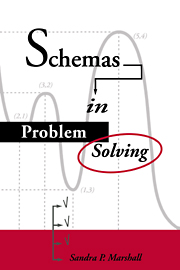3 - The schemas of arithmetic story problems
Published online by Cambridge University Press: 22 October 2009
Summary
Let us begin with the premise that successful problem solving in a specified domain depends upon the schemas that a person possesses. It should be immediately evident that we need to ascertain which schemas and how many of them are needed to solve problems. Almost certainly, for any complex domain these questions can be answered in numerous ways. What we seek is a basis set of schemas, that is, a minimal set of schemas that is sufficient to solve all problems in the domain. Like the basis of a vector space–a minimal, spanning set–the basis set of schemas would be all that is needed to generate, through suitable combinations of its members, the entire space of problem-solving capabilities. Clearly, a basis set would consist of high-level schemas having strong interconnections to lower-level schemas and accessing these lower-level ones as needed.
The approach described here derives from the idea that in any problem-solving domain, only a limited set of basic situations will occur. The number of basic situations is presumed to be small, but many complex situations can arise because the basic ones can be logically combined in many ways. Given that there is but a small collection of basic situations, the objective is to delineate one and only one schema for each of them. Just as basic situations combine to create complex situations, the corresponding basic schemas are combined in solving complex problems.
- Type
- Chapter
- Information
- Schemas in Problem Solving , pp. 62 - 110Publisher: Cambridge University PressPrint publication year: 1995



